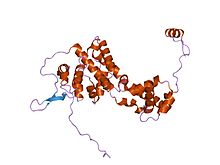|
Borna disease virus
The Borna disease viruses 1 and 2 (BoDV-1 and BoDV-2) are members of the species Mammalian 1 orthobornavirus and cause Borna disease in mammals. VirologyGenomeBoDV-1/2 have the smallest genome (8.9 kilobases) of any Mononegavirales member and are unique within that order in their ability to replicate within the host cell nucleus. BoDV-1 was isolated from a diseased horse in the 1970s, but the virus particles were difficult to characterise. Nonetheless, the virus' genome has been characterised. It is a linear negative-sense single stranded RNA virus in the order Mononegavirales. Several of the proteins encoded by the BoDV-1 genome have been characterised. The G glycoprotein is important for viral entry into the host cell.[1][2] It has been suggested that the p10, or X, protein plays a role in viral RNA synthesis or ribonucleoprotein transport.[3] The P40 nucleoprotein from BoDV-1 is multi-helical in structure and can be divided into two subdomains, each of which has an alpha-bundle topology.[4] The nucleoprotein assembles into a planar homotetramer, with the RNA genome either wrapping around the outside of the tetramer or possibly fitting within the charged central channel of the tetramer . P24 (phosphoprotein 24) is an essential component of the RNA polymerase transcription and replication complex. P24 is encoded by open reading frame II (ORF-II) and undergoes high rates of mutation in humans. It [binds amphoterin-HMGB1, a multifunctional protein, directly and may cause deleterious effects in cellular functions by interference with HMGB1.[5] Horse and human P24 have no species-specific amino acid residues, suggesting that the two viruses are related.[6][7] Numerous interactions of the immune system with the central nervous system have been described. Mood and psychotic disorders, such as severe depression and schizophrenia, are both heterogeneous disorders regarding clinical symptomatology, the acuity of symptoms, the clinical course and the treatment response.[8] BoDV-1 p24 RNA has been detected in the peripheral blood mononuclear cells (PBMCs) of psychiatric patients with such conditions.[7] Some studies find a significant difference in the prevalence of BDV p24 RNA in patients with mood disorders and schizophrenia,[9] whilst others find no difference between patients and control groups.[7] Consequently, debate about the role of BDV in psychiatric diseases remains alive. ReplicationBornaviruses enter host cells by endocytosis. The viral genome and associated viral proteins is released into the cytoplasm following fusion of the viral envelope and the endosome membrane.[10] Replication of bornaviruses occurs inside the nucleus. These are the only animal viruses within the order Mononegavirales to do this. Many plant rhabdoviruses replicate in the nucleus. Bornaviruses have negative sense RNA genomes[11] The negative sense RNA is copied to make a positive sense RNA template. This template is then used to synthesise many copies of the negative sense RNA genome. This is like making copies of a mold, and then using these molds to make many more viruses. Endogenous provirusEndogenous viral elements homologous to the nucleoprotein gene of BoDV-1 have been shown to exist in the genomes of several mammalian species, including humans and non-human primates.[12] EvolutionA Bayesian analysis of Borna disease virus 1 suggests that the current strains diversified ~300 years ago and that avian-host bornaviruses evolved considerably earlier than this.[13] The ancestral virus seems likely to have been a high AT content virus. HistoryBorna disease was first described in 1885 as "heated head disease" of cavalry horses in 1885 in the town of Borna, Germany.[14] References
External links |
||||||||||||||||||||||||||||||||||||||||||||||||||||||||||||||||||||||||||||||||||||||||||||||||||||||||||
